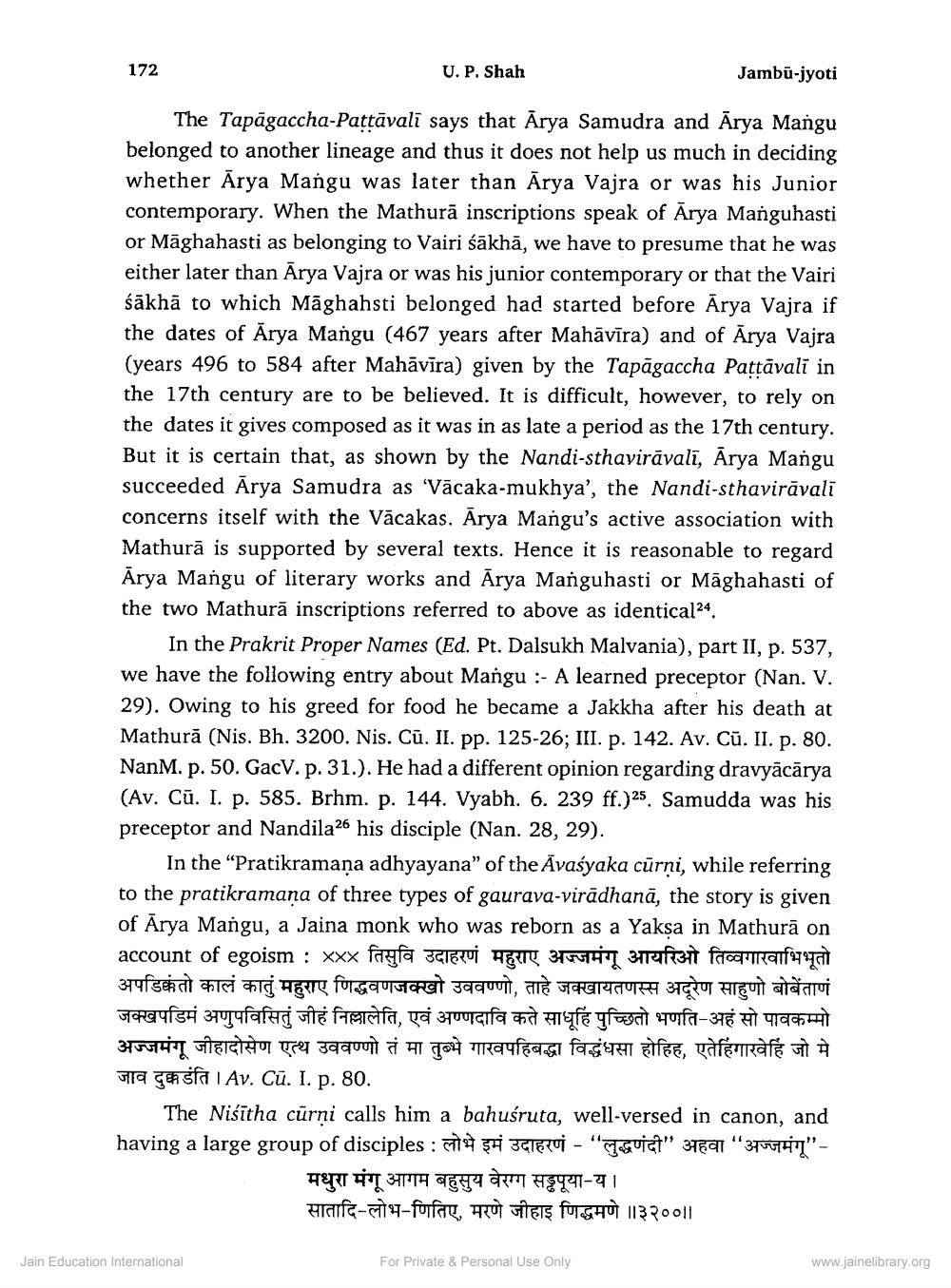________________
Jambū-jyoti
The Tapagaccha-Paṭṭāvalī says that Ārya Samudra and Arya Mangu belonged to another lineage and thus it does not help us much in deciding whether Arya Mangu was later than Arya Vajra or was his Junior contemporary. When the Mathura inscriptions speak of Arya Manguhasti or Maghahasti as belonging to Vairi śākhā, we have to presume that he was either later than Arya Vajra or was his junior contemporary or that the Vairi śākhā to which Maghahsti belonged had started before Arya Vajra if the dates of Arya Mangu (467 years after Mahāvīra) and of Arya Vajra (years 496 to 584 after Mahāvīra) given by the Tapagaccha Paṭṭāvali in the 17th century are to be believed. It is difficult, however, to rely on the dates it gives composed as it was in as late a period as the 17th century. But it is certain that, as shown by the Nandi-sthavirāvalī, Ārya Mangu succeeded Ārya Samudra as 'Vācaka-mukhya', the Nandi-sthavirāvalī concerns itself with the Vācakas. Ārya Mangu's active association with Mathura is supported by several texts. Hence it is reasonable to regard Arya Mangu of literary works and Arya Manguhasti or Maghahasti of the two Mathurā inscriptions referred to above as identical24.
172
U. P. Shah
In the Prakrit Proper Names (Ed. Pt. Dalsukh Malvania), part II, p. 537, we have the following entry about Mangu :- A learned preceptor (Nan. V. 29). Owing to his greed for food he became a Jakkha after his death at Mathurā (Nis. Bh. 3200. Nis. Cũ. II. pp. 125-26; III. p. 142. Av. Cũ. II. p. 80. NanM. p. 50. GacV. p. 31.). He had a different opinion regarding dravyācārya (Av. Cū. I. p. 585. Brhm. p. 144. Vyabh. 6. 239 ff.)25. Samudda was his preceptor and Nandila26 his disciple (Nan. 28, 29).
In the "Pratikramana adhyayana" of the Avasyaka cūrņi, while referring to the pratikramana of three types of gaurava-virādhanā, the story is given of Arya Mangu, a Jaina monk who was reborn as a Yakṣa in Mathurā on account of egoism: xxx तिसुवि उदाहरणं महुराए अज्जमंगू आयरिओ तिव्वगारवाभिभूतो अपडिक्कतो कालं कातुं महुराए णिद्धवणजक्खो उववण्णो, ताहे जक्खायतणस्स अदूरेण साहुणो बोबेंताणं जक्खपडिमं अणुपविसितुं जीहं निल्लालेति, एवं अण्णदावि कते साधूर्हि पुच्छितो भणति - अहं सो पावकम्मो अज्जमंगू जीहादोसेण एत्थ उववण्णो तं मा तुब्भे गारवपहिबद्धा विद्धंधसा होहिह, एतेहिंगारवेहिं जो मे Gagesfa Av. Cù. I. p. 80.
The Niśitha cürni calls him a bahuśruta, well-versed in canon, and having a large group of disciples : लोभे इमं उदाहरणं - "लुद्धणंदी” अहवा "अज्जमंगू”
Jain Education International
मधुरा मंगू आगम बहुसुय वेरग्ग सड्ढपूया-य । सातादि - लोभ - णितिए, मरणे जीहाइ णिद्धमणे ॥३२०० ||
For Private & Personal Use Only
www.jainelibrary.org




